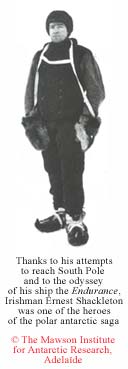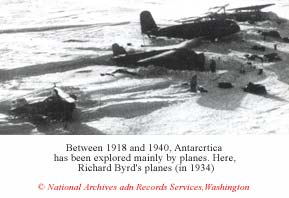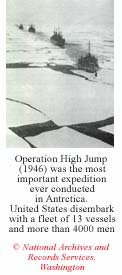|
  
|
 |






|
 Antarctic Polar Regions | A short History of the Antarctic Antarctic Polar Regions | A short History of the Antarctic
Dramas, Tragedies and Exploits (Page 3)
The Discovery of The Antarctic between the two Wars.
Amundsen's feat and Scott's drama made a lot of noise in the world and the Antarctic was suddenly front-page international news once again. At that time, there were many nations that also wanted, for their part, to involve themselves in the conquest of the 6th Continent and to inscribe their name somewhere on that land that still belonged to nobody. The hopes were all the more fervent that the still undiscovered regions were vast and that the discovery of new technologies would succeed in feeding the craziest of dreams. |
1911 : Germany.
a German expedition led by Lieutenant-Major Wilhelm Filchner left Bremerhaven aboard a Three-Master, the Deutschland, to go to the Antarctic. Its objective was to verify whether there was a continent between the Weddell Sea and the Ross Sea or rather an immense channel of frozen water. Arrived in the Weddell Sea, they discovered the coastal promontory, which today bears the name of the Filchner Ice Shelf, and they built a hut from which they were to set off on ski-treks towards the South. But an enormous iceberg broke away from the ice shelf where they had set up home and the Germans were obliged to disassemble everything and beat a retreat. The southern winter was at the door and the Deutschland began to drift with the ice floe. In order to spend these difficult months at greater ease, the leader decided on another landing.
Despite some ski-treks inland of the ice and the discovery of important geographical places located on the south shore of the Weddell Sea, the expedition was a failure.
1911 : Australia.
Douglas Mawson was a beginner in terms of Antarctic discovery; he had in fact participated in Shackleton's expedition of 1908-1909 and had even given himself the fright of his life by falling into a crevice when he and his two companions were returning to base after being the first to reach the magnetic South Pole. In 1911, the Australian decided to go and map the 3,000 kilometres of Antarctic coast that were opposite the southern coast of his country. He set up his H.Q. (two prefabricated houses that could hold 20 or so people), in Commonwealth Bay on a rocky promontory that descended toward the sea while his ship was to deposit another team of 8 men some  2,500 kilometres away from there. The two years spent by the Australasian Expedition in Antarctica were to be devoted to ski-treks with sledges along the shores, which contributed a mass of topographical information of paramount importance. But terrible blizzards blowing at times at more than 200 kilometres per hour delayed the Australian's projects and made it difficult to progress on sledges. In fact, without knowing it, Mawson had set up his base in one of the windiest places of the whole Continent. 2,500 kilometres away from there. The two years spent by the Australasian Expedition in Antarctica were to be devoted to ski-treks with sledges along the shores, which contributed a mass of topographical information of paramount importance. But terrible blizzards blowing at times at more than 200 kilometres per hour delayed the Australian's projects and made it difficult to progress on sledges. In fact, without knowing it, Mawson had set up his base in one of the windiest places of the whole Continent.
During a ski-trek toward the East, Mawson lost the two companions that were accompanying him; the first fell into a crevice, and the other a Swiss mountaineer of 28 years, died exhausted on the sledge that the expedition leader was in the process of pulling. The later managed nevertheless to reach the base. When he rejoined his companions, his condition was lamentable, he had virtually no more hair and the ends of his limbs had begun to rot a while earlier.
1922 : Ernest Shackleton.
The famous English explorer, who meanwhile had become Sir Ernest Shackleton, was to go off once again into the Antarctic to direct mapping operations in the region of the Weddell Sea. But having knocked about so much, the man was tired. On 04 January, he suffered a heart attack on board the ship that was taking him to the area and, at the age of 42, he died in his cabin. At the request of his widow, his companions buried him in South Georgia.
1928 : Flying Over The Antarctic.
The Australian explorer Hubert Wilkins (1888-1958) made the first flight in a Lockheed Vega, including a flight of more than 1,000 kilometres, over the Antarctic in the region of Bransfield, setting out from Deception Island.
1929 : United States. 
The American Richard Evelyn Byrd (1888-1957) is another mythical figure of southern conquest. It was he, in effect, who had laid the foundations for air transport in the Polar Regions. Three years after being the first to overfly the North Pole (1926), he led a private expedition in Antarctica and founded the 'Little America' base on the Ross Ice Shelf, in the area of the Bay of Whales. It was a question of a genuine underground town where some 40 men were living; this was, in any event, the first Antarctic base worthy of the name. With its three aeroplanes, its research teams and its 95 dogs, this expedition was a forerunner of the gigantic operations that the Untied States were to conduct in the Antarctic several years later.
Richard Byrd was also the first pilot in the world to overfly the South Pole, a flight that was prepared with minute detail at the base during the long southern winter. There were four on board; Bernt Balchen, pilot, Byrd, navigator, Harold June, radio operator and Ashley McKinley, photographer. The flight took 16 hours and practically followed Amundsen's itinerary.
It was also in the course of this expedition that a scientific ski-trek of 2,000 kilometres in land of the ice, brought to 'Little America' geological samples proving that the mountains from where these pieces of rock had been taken were indeed parts of a continent.
It is interesting to note that at the time when the White Continent was little by little being colonised by technology and machines, the exploits were still dependent on the good old technique of sledges pulled by dogs. If Byrd had been able to succeed with his flight to the Pole, it was because several of his teams had, before the exploit, covered half the distance between 'Little America' and the Pole; ski-treks with dog sledges in the course of which meteorological observations had been made, (without which Byrd would have been unable to set off) and stockpiles of fuel organized. In June 1930, Richard Byrd returned to New York where he received a hero's welcome.
1929 - 1930 : BANZARE: First International Expedition.
As territorial claims on the Antarctic Continent began to emerge, the Antarctic shores had to be mapped as quickly as possible so that people could land on the shores before others and plant their respective flags. It was with this idea in mind that an expedition organized jointly by the English, the New Zealanders and the Australians set off. Banzare was the logo of the British Australian New Zealand Antarctic Research Expedition; of course, to avoid arousing suspicions, the project was given a scientific priority. The leader of this first international expedition was called Douglas Mawson. Certainly, they would be putting scientists on the land; but the pilots were especially concerned with overflying the coasts, landing wherever they could and planting the Union Jack as frequently as possible. Two missions were conducted in this way. When they returned, the British authorities proclaimed the sovereignty of the King on the discovered lands and placed these new territories 'under the protectorate of the Commonwealth'. From now on, the Antarctic would no longer be considered as a no man's land.
1934 : Alone In The Great South.
As years went by, the United States intensified their presence in the Antarctic. It was once more at the head of an impressive scientific expedition that Richard Byrd returned to 'Little America' in January 1934. It contained, in effect, three aeroplanes, 56 men, 153 dogs, a tractor, 2 snowmobiles and 2 Citroen crawler vehicles. To the credit of this new operation: the proof that between the Weddell Sea and the floating Ross Ice Shelf, there was indeed a continent that existed and not just frozen water.
One year later, Byrd decided to set up a sophisticated weather station 200 kilometres from 'Little America' and to spend the winter there on his own. Another page of Antarctic History was written between the months of July and August 1934. For the American was going to live for two months between life and death. The carbon monoxide fumes from his stove and generator, in this tiny cabin buried beneath the ice, were the cause of this slow intoxication. But what could be done? In temperatures of -79°, he was nonetheless obliged to keep himself warm! Just as Scott had done before him, the American explorer demonstrated an extraordinary sense of duty and devotion; he knew that the only solution for him personally would be to warn his comrades, who were still at 'Little America' since he was in regular contact with them. But he also knew that a 200-kilometre journey in the polar night would oblige the rescue team to take enormous risks. Furthermore, the latter would not even be certain of finding the site of his weather station. At the end of the long southern winter everything fell into place. His companions finally began to wonder what was going on. When Byrd was joined by his men, he was terribly weak and he had to spend a further two months on the spot before being able to board the plane that brought him to 'Little America'. Five years later, in 1939, the same Richard Byrd returned to Antarctica at the head of an expedition, this time organized by the U.S. Antarctic Service for the primary purpose of conducting scientific observations.
1935 : A Millionaire Buys The First Trans-Antarctic Flight For Himself.
To overfly the whole of the Antarctic Continent: a rave of the American millionaire Lincoln Ellsworth. He nonetheless was going to have to make three attempts before succeeding. The first ended in a minor catastrophe. The piece of ice floe where the monoplane had been installed had separated from the base practically beneath the adventurers' feet.
The second time (in 1935), the businessman was no longer proposing to make the return trip Ross-Weddell as initially envisaged, but to depart from the Weddell Sea and to reach the Ross Ice Shelf. It was in any case a first; nobody in effect had crossed the continent. A new failure: in two months of waiting, they only had half a day of good weather.
Third journey: The base camp was established on Dundee Island, on the end of the Antarctic Peninsula. On 23 November, Elsworth accompanied the pilot Herbert Hollick-Kenyon on a flight of 3,500 kilometres.
What was the interest in such an attempt? To overfly regions where man had never set foot, to take aerial photographs and to satisfy a millionaire's ego. The two men had to land twice because of weather conditions. When they finally came above the Ross Ice Shelf, after a week of travelling, (initially the flight should have lasted 15 hours), they had to land for one last time and give up any idea of going further; the monoplane was out of fuel. On 15 December, the two aviators arrived back at 'Little America' by sledge. The ship that was to have come to collect them at the other side of the Antarctic was at the rendezvous.
1936 - 37 : The English Again.
A British expedition spent two years in the waters of the Antarctic Peninsula, which they explored even more deeply than Gerlache had in 1897. Thanks to a seaplane, the discovered numerous passages of open water and made an important contribution to the geographical knowledge of that part of the continent.
 1946 : Operation High Jump. When the Americans Spare no Expense. 1946 : Operation High Jump. When the Americans Spare no Expense.
It was without doubt a question of one of the largest operations ever conducted on the southern Continent. It was the U.S. Navy that was in charge of the programme and the veteran Richard Byrd in command. The avowed aim of this gigantic expedition: as always, scientific observations, but also and especially aerial photography and the topography of the region.
4,700 men, 13 ships (including an aircraft carrier and a submarine), 50 helicopters, 23 planes and seaplanes were conveyed to the area. A base was constructed around the former 'Little America'. Hundreds of tents were deployed where 500 men were installed, virtually on a war footing. An aviation area was laid out, for it was aerial reconnaissance that was going to take pride of place. The deployment of forces was unimaginable: all the technological equipment that existed at the time was used. As, for example, an airborne magnetometer that could determine the type of rock from the aeroplane that was flying over it. In the course of the six weeks that the operations lasted, Operation High Jump overflew several million square kilometres, discovered three mountain chains, until then unknown, and covered 36,000 kilometres in the air. On the other hand, the technicians were able to take 70,000 aerial photographs; 60% of the Antarctic coast could thus be studied and mapped.
What this American Armada had not envisaged was the lack of visibility at ground level. The aerial photographs were therefore not a great deal of use. In order quickly to camouflage this gaffe, they sent another important expedition into those same regions one year later, which was tasked, for its part, to study the topography of the shores close at hand and to stake them out with precise reference points. At the time of this journey, poor weather conditions were to prevent the Americans from concerning themselves with more than 1,000 kilometres of coastline.

The following sources were used to draft this chapter, as well as Chapter 1 'A Discovery Waiting To Happen' :
Antarctica, The Extraordinary History Of Man's Conquest Of The Frozen Continent, Reader's Digest Association Limited, Australia, 1985.
The Explorations of Antarctica, The Last Unspoilt Continent, G.E. Fogg & David Smith.
Fifteen Months In The Antarctic, Adrien de Gerlache.
Victory Over The Antarctic Night, Adrien de Gerlache.
The Odyssey Of The Endurance, The First Attempt To Cross The Antarctic, Sir Ernest Shackleton. Explore Antarctica, Louise Crossley.
At The Heart Of The Antarctic Toward The South Pole, 1908-1909, Sir Ernest Shackleton.
Explorers & Explorations, Raymond Cartier. |

 2,500 kilometres away from there. The two years spent by the Australasian Expedition in Antarctica were to be devoted to ski-treks with sledges along the shores, which contributed a mass of topographical information of paramount importance. But terrible blizzards blowing at times at more than 200 kilometres per hour delayed the Australian's projects and made it difficult to progress on sledges. In fact, without knowing it, Mawson had set up his base in one of the windiest places of the whole Continent.
2,500 kilometres away from there. The two years spent by the Australasian Expedition in Antarctica were to be devoted to ski-treks with sledges along the shores, which contributed a mass of topographical information of paramount importance. But terrible blizzards blowing at times at more than 200 kilometres per hour delayed the Australian's projects and made it difficult to progress on sledges. In fact, without knowing it, Mawson had set up his base in one of the windiest places of the whole Continent.
 1946 : Operation High Jump. When the Americans Spare no Expense.
1946 : Operation High Jump. When the Americans Spare no Expense.